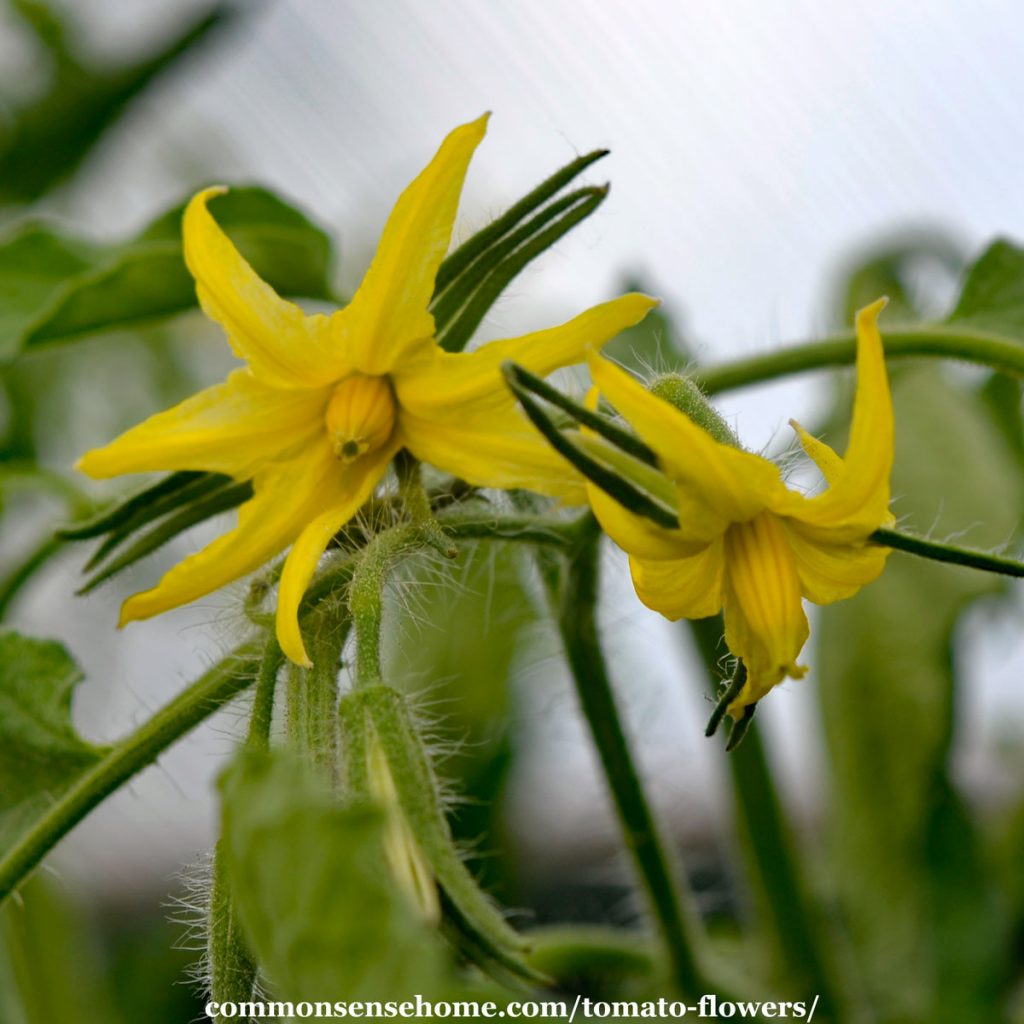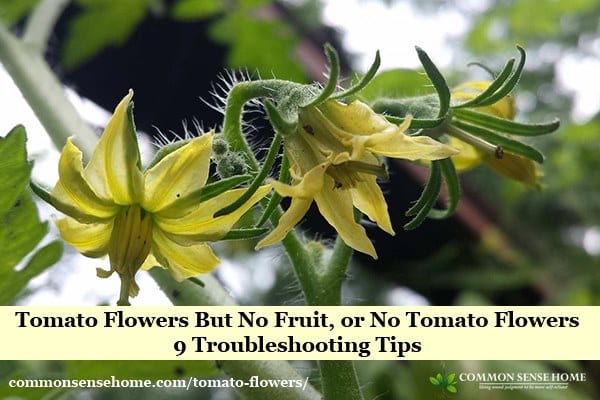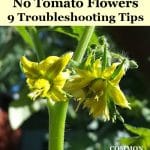Tomato Flowers But No Fruit – 9 Troubleshooting Tips
It’s very frustrating when you have tomato flowers but no fruit, or big, beautiful tomato plants but no tomato flowers at all. Thankfully, most of the time you can get your tomatoes producing with a little extra TLC.

In this post, we’ll look at two tomato flower problems – no flowers at all, and tomato flowers but no fruit.
5 Common Causes of Tomatoes Not Flowering
So you have these beautiful, green, lush, tomato plants but no flowers – what gives? There are several factors that can keep your tomato plants from flowering.
#1 – Too Much Nitrogen
When I asked garden expert and commercial nursery owner, Emme Nicols, why tomatoes won’t flower, she said, “Too much nitrogen. People are programmed to use the same fertilizer for everything and down south, that usually means 10-10-10. They put that stuff on everything. While excessive nitrogen will yield beautiful green leaves, it does very little in helping promote flowering.”
Tomatoes are heavy feeders, and require nitrogen, phosphorus and potassium, plus many micro-nutrients. To produce flowers, they need less nitrogen and more phosphorus.
The University of Missouri recommends a fertilizer low in nitrogen, high in phosphorus and with a medium to high amount of potassium.
Try using a fertilizer such as Jobe’s Organic Tomato Fertilizer to help promote flower production. You might also consider a foliar spray like Feed the Leaf Organic Blooms.
When you have rampant green growth from too much nitrogen and no flowers, you may want to prune some of the leaves and remove the suckers. (Do not prune determinate plants.)
This allows the plant to focus its energy on producing flowers and not feeding the leaves.
#2 – Too Hot
Tomatoes are native to subtropical Central America. They evolved to need it warm (but not too warm) to form their fruit .
A temperature range of 65 to 75ºF (18-24°C) is ideal. During extreme heat, the tomatoes will stop flower production.
Be patient, and when the weather cools down a little, your tomatoes should start flowering again. Make sure you keep them watered and fertilized while waiting for the temperatures to fall.

#3 – Not Enough Water
Tomato plants need about 1 to 1 1/2 inches of water each week to fruit, according to Ohio State University.
The key to healthy tomato plants is to never let them dry out, or get flooded, but to keep the soil evenly moist. You can help your plants retain moisture by adding organic mulch and compost around the base of the plant.
#4 – Tomato Variety
Some tomatoes are known to be heavy producers and some are sought after for their big fruit.
Big fruiting varieties like the Mortgage Lifter, will only produce an average of six tomatoes per plant for the entire season- that’s it. (Editor’s note: the strain of Mortgage Lifter I’ve been growing for several years produces many more than six fruits per plant.)
If you want a more abundant tomato harvest, I suggest a smaller heirloom variety like Red Brandywine. Red Brandywine is a heavy producer and offers a beautiful, medium size fruit.
(Editor’s note: I’m a paste tomato fan because we make so many homemade tomato products like salsa, sauce and soup. My all time favorites are Opalka and Amish Paste, which produce an abundance of meaty tomatoes.)
In addition to variety, the type of tomato plant you have will play a role in production as well.
- Determinate Tomato Plants are called so because they grow to a determined height. They are short, bushy and known to produce early in the season. Once fruiting is done, it’s done – the plant will set no more fruit.
- Indeterminate Tomato Plants grow to an undetermined height (mine have grown over 10 ft!). They are long, leggy, and may set fruit until the first frost.
If you have a determinate tomato variety, your tomato season may already be over.
If you have an indeterminate variety and you are not seeing flowers, or are seeing flowers but no fruit, continue reading to help determine the cause.
See “Types of Tomatoes (Best Uses, Flavors, and Plant Sizes)” for more information on tomato varieties.
#5 – Not Enough Sun
Fruiting vegetables, such as tomatoes, require six-eight hours of sunlight per day to thrive and produce fruit. Less light may equal production issues, such as no flowers or flowers but no fruit.
Would you like to save this?
Container plants can be moved to a sunnier location, but if you garden doesn’t get enough sun, fruiting plants will be less productive.

4 Common Causes of Tomato Flowers But No Fruit
What if your tomato plants have plenty of flowers, no visible health issues, but no fruit?
Tomatoes are self-pollinating, meaning they have both the male and female parts. This means that they may be able to pollinate and set fruit even without bees, but sometimes things go awry in the reproduction department.
Some things we can fix, some we can’t. Here are some of most common causes of tomato flowers but no fruit.
#1 – Blossom Drop
Blossom drop happens because it’s too cold or too hot. According to Ohio State University:
Air temperature is an important factor in the production of tomatoes, which are particularly sensitive to low night temperatures and extremely high temperatures. Blossom drop can occur in early spring when daytime temperatures are warm, but night temperatures fall below 55°F.
This phenomenon will occur during the summer as well, when daytime temperatures are above 90°F and night temperatures are above 75°F.
For high temps, a shade cloth may be used to block some of the afternoon sun and beat the worst of the heat.
For cold temps, consider red plastic mulch sheeting (this can go over organic mulch and be reused for several years). You might also find a grow tunnel or floating row cover boosts temps enough to promote fruiting.
#2 – High Humidity
Tomatoes reproduce by their pollen falling from the stamen and pollinating the stigma. Generally this pollination happens by wind, movement and vibration of a bees wings.
High humidity can impede this this process by making the pollen too wet to freely transfer to its destination.
If you live in a climate with high humidity, you can help pollinate your tomato plants by gently tapping on the flowers or flower stems.
Another option is to gently brush pollen from one flower to another with a small paintbrush.
#3 – Poor Air Circulation
As I mentioned above, flowers are self-pollinating and set pollen via movement. If the air flow around the tomato is hindered, the pollen can not fall and pollinate the stigma. To improve air circulation, try some of the following options:
- Remove some of the foliage, such as suckers.
- Don’t plant your tomatoes too close. Space determinate varieties 12-24″ apart and indeterminate varieties 36-48″ apart.
- Trellis your tomato plants. Grow your tomatoes vertically to improve air circulation. (See tomato trellis ideas.)
- Don’t plant next to a building or structure. Instead, plant your tomatoes where they have open air on all sides.
#4 – Too Many Flowers
Too many flowers on a tomato plant will cause competition for nutrients among the flowers. As a preservation method, the tomato plant will automatically abort and drop flowers.
After your plant goes through a fruiting process, this problem should correct itself without intervention as long as the soil is good.
If in doubt, try a fertilizer such as Jobe’s Organic Tomato Fertilizer, as mentioned above.
Don’t Give Up on Homegrown Tomatoes!
There can be a learning curve to abundant tomato production, but the effort is worth it. Fresh picked tomatoes are one of the best treats available from the home garden.
Need more tomato growing tips? Check out these other posts on the site:
- Grow Tomatoes from Seed – Save Money, Get More Varieties
- How to Grow Lots of Tomatoes Organically, Plus Innovative Gardening Techniques
- 4 Reasons your Tomatoes Aren’t Ripening
- 7 Steps to Stop Blossom End Rot & Get Rid of Black Bottomed Tomatoes
Questions, comments or some tips of your own you’d like to share? Please leave a comment below.

This is a guest post by Amber Bradshaw of My Homestead Life.
Amber and her family moved from their tiny homestead by the ocean in South Carolina to forty-six acres in the Smoky Mountains in East Tennessee.
While building their off-the-grid homestead, they live like the days of old – cooking without electricity, collecting water from the creek and raising chickens, goats, pigs, turkeys, bees, and guineas. They’ve recently filmed their journey for a TV show on the Discovery Channel and the DIY Network/HGTV called Building Off The Grid: The Smokey Mountain Homestead.
Last updated in 2018.


My tomatoe plant finally blossomed and i do have some tomatoes. I want to know if they will turn ripe or red before fall?
Given that fall starts tomorrow, I don’t think they’ll be ripe by then unless they are close to it today. Whether or not they will have time to ripen at all depends on your frost date, and if you protect them from frost. If your frost date is later in the year, they may have time to ripen.
Be aware that tomatoes tend to ripen more slowly in cooler temperatures with shorter days as we head into fall.
In tomato fruits are not setting
Please see the second half of the article.
You can see the post “4 Reasons Your Tomatoes Are Not Ripening + How You Can Help” for more information.
Have six tomato plants. Five have produced all summer. the other has bloomed all summer but has never set a tomato. All plants have received the same fertilizer and water. Any suggestion or conclusion.
Is it a different variety? I tried to grow Evergreen tomatoes one year, and all the other types of tomatoes around them had a good harvest, but the Evergreen plants just sat there.
little flowers, no fruit, but too many differnt fertilers to use and amounts.
Could you rephrase the question, if you have a question?
My tomatoes are healthy looking about. 6-7 foot tall little flowering but no fruit please help
The article covers the different possible reasons for your lack of fruit and blossoms. We hope to have a video up by the end of the week for those who prefer watching over reading.
How can i get rid of squirrels visiting my garden?
If there is a large population of squirrels in your area, it will be difficult if not impossible to keep them out of your garden without reducing that population.
If you have bird feeders nearby, stop stocking them. If your neighbors are feeding the birds (and squirrels), there’s not much chance of keeping them out of the area.
Some dogs or cats will help deter squirrels.
Live traps are a possibility, but then you’d need to find a place to release the squirrels.
If hunting is legal in your area, squirrels are fairly tasty.
You can try liquid fence and planting extremely fragrant herbs in your veggies, but those are likely to only be minimally effective. The same goes for many physical fences – squirrels just climb over them. A smooth, tall fence might work.
So i put blood meal to get rid of squirrels but now they are writing too much nitrogen wont give tomatoes . Im not getting flowers . Is there something i can put to give me flowers but get the squirrels off?
Try a liquid fence type product for the squirrels, and add some phosphorus and potassium for the tomatoes.
Got tomato plants in large buckets and had blooms to come on but fell off and no fruit.coming on ,what do I do to get fruit
Did you have a temperature or humidity changes? Are the tomatoes evenly and regularly watered?
When you grow tomatoes in containers, it can be challenging to keep the soil moisture level right. Pay close attention to watering, and try using a fertilizer low in nitrogen, high in phosphorus and with a medium to high amount of potassium.
I have a crop of tomatoes that are growing in my first attempt at wicking beds. The plants grew very well with masses of green vegetation but the fruit setting are tiny and not developing well. We have gone through two heat-waves with temperatures up to 45˚C one day. No damage but little fruit.
All the other plants in the wicking beds are mammoth but with small product, eg little carrot roots.
I guess my problem is a combination of too much nitrogen and too much heat! Any other thoughts?
Have you done a soil test? You might be low on other nutrients, too. I suspect the heat is the biggest issue.
Dear Laurie,
No I haven’t, apart from pH which we did when we made up the batch of soil for the wicking beds. I have been eyeing off one of those combined qualitative tests that just say “nutrients low or nutrients high {NPK}” and another that can separately analyse N, P and K. What do you use?
We have used the simple home NPK tests, but they aren’t always the most accurate. Still, they are inexpensive, and it’s a place to start. I talk about different types of home soil testing here https://commonsensehome.com/soil-testing/
have a potted beef stake tomato plant ,was a beautiful flowing plant ,its gone through heat / sun problem ,moved to patio to protect it from Arizona heat/sun,then went through hawk moth green worms now poor thing flowers have whether up and don’t see any new growth of buds ..I have cut back foliage and started giving it more water was using a watering tube daily when it was out in yard sun .backed off when moved to the patio less sun only gets morning sun 6 hours then ,shaded the rest of day also have high winds protection
Do you know if your plant is a determinate or indeterminate variety? If it’s a determinate variety (which is typically recommended for growing in pots due to space limitations), they only grow so big, and then blossom and set fruit and are done. They won’t put out new growth beyond that point in their life cycle. In other words, it may be a goner.
How to increase flower in Tomato plant reply
As noted in the post:
Tomatoes are heavy feeders, and require nitrogen, phosphorus and potassium, plus many micro-nutrients. To produce flowers, they need less nitrogen and more phosphorus. The University of Missouri recommends a fertilizer low in nitrogen, high in phosphorus and with a medium to high amount of potassium.Try using a fertilizer such as Jobe’s Organic Tomato Fertilizer to help promote flower production. You might also consider a foliar spray like Feed the Leaf Organic Blooms.
When you have rampant green growth from too much nitrogen and no flowers, you may want to prune some of the leaves and remove the suckers. (Do not prune determinate plants.) This way the plant can focus its energy on producing flowers and not feeding the leaves.
Please see also points 1-5 “Common Causes of Tomatoes Not Flowering”.
AMBER i live in mid GA. an always used 10-10-10 on my garden now i find out i am wrong,using granules at planting i then use liquid 10-10-10 for folier application what would you use at planting an for folier application through season also what micro nutrients an how to apply in correct amounts
I like Espoma Tomato-tone Organic Fertilizer. The bag recommends applying every two weeks.
Please advise readers not to use peat products as it is a non-renewable source. Other products such as perlite and azomite are also not environmentally-friendly as they have to be extracted by mining which is one of the most polluting human activities. Home-made compost is the best way to amend existing soil.